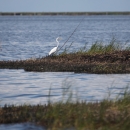History
A major settlement for the Grand Calumet River / Indiana Harbor Canal and the Nearshore Areas of Lake Michigan Natural Resource Damage Assessment case was proposed in a consent decree lodged with the Northern District Court of Indiana on August 20, 2004. This settlement is with eight companies and includes a cash payment of $56.3 million; permanent protection of 233 acres of globally rare dune and swale habitats; and $2.7 million to repay Indiana Department of Environmental Management and U.S. Fish and Wildlife Service (Service) for their damage assessment work.
The Service's Bloomington Indiana Field Office began work to bring a natural resource damage case for the Grand Calumet River in 1989. In 1996, the Service joined with our Co-trustees, the Indiana Department of Environmental Management and the Indiana Department of Natural Resources and officially initiated a Natural Resource Damage assessment. Settlement negotiations began in 1997 with nine Potentially Responsible Parties. They are: Atlantic Richfield Company (and ARCO Environmental Remediation, L.L.C.); BP Products North America Inc.; E.I. Du Pont De Nemours and Company; Exxon Mobile Corporation; GATX Corporation; Georgia-Pacific Corporation; ISPAT-Inland Inc.; United States Steel Corporation; and, LTV Steel Corporation. In 2001, LTV Steel filed for bankruptcy and more than $4 million was paid to the Trustees through the bankruptcy proceedings.
This NRDA settlement grants protection to an additional 233 acres of globally rare dune and swale habitats and some additional GCR riparian riparian
Definition of riparian habitat or riparian areas.
Learn more about riparian / wetland habitats that are valuable for migratory birds. Additional habitat restoration will continue in this area as the trustees work to develop an appropriate sediment management plan to remove or contain approximately 2.5 million cubic yards of contaminated sediments from the river. The contamination associated with these sediments continue to harm all aspects of biota from fish and frogs to migratory birds. We hope that someday this river will fulfill its original functions to support a healthy ecosystem. This agreement meets the statutory requirements to restore, replace, rehabilitate, and/or acquire the equivalent of the lost natural resources.
Grand Calumet River Restoration Fund Council
The Grand Calumet River Restoration Fund (GCRRF) was established by Trust Agreement after settlement with "Industrial Users" in the case "United States of America v. The Sanitary District of Hammond, et al., Civ. Action No. 2:93-CV-225 JM." The purpose of the Fund, as established in the Trust Agreement is to "...address and correct environmental contamination in the Area of Concern, including the cleanup of contaminated sediment and the remediation and restoration of natural resource damages within the Area of Concern....and, more specifically, in and around the West Branch of the Grand Calumet River in the State of Indiana (the "Hammond Reach")."
The U.S. Fish and Wildlife Service is in the process of updating webpages, so some content that was previously available is temporarily unavailable. Please contact Dan Sparks for additional information.




